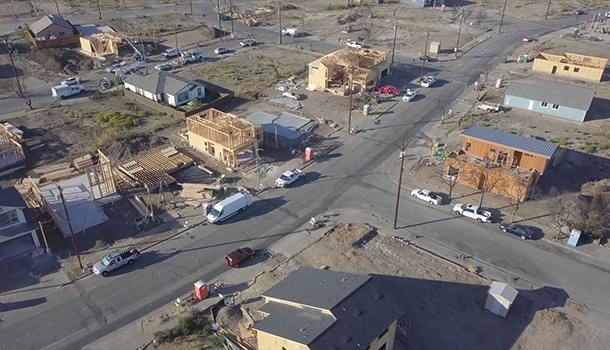
(Photo: Angel Cardenas/CAFwd)
Housing in Sonoma County was the top priority for political, business and philanthropic leaders who met last year after the devasting 2017 fires destroyed more than 5,100 homes. Since that first meeting participants hit the ground running to ensure the region not only recover lost housing, but also establish an environment to create new and affordable housing.
“We’re organizing a grassroots campaign to be pro-housing to support projects that come up,” said Santa Rosa Metro Chamber CEO Peter Rumble on the establishment of the Sonoma County Housing Council, which brings together 15 of the region’s largest employers to invest in housing projects and is in the process of establishing a local housing trust.
It is a much-needed vehicle in the region as there was previously no local housing fund. Added Rumble, “To be able to have a separate fund that can be used to help bridge the gap of affordable or workforce level housing in addition to any funds that might be available through the public process is a tremendous boon for the community.”
While the Santa Rosa Metro Chamber was creating the Housing Council, the City of Santa Rosa was laying the groundwork to make housing a priority.
“The big focus this past year has been on housing elements,” said David Guhin, Santa Rosa’s assistant city manager and director of economic development. “We put a number of policies into place over the past year in anticipation on focusing on infill development and setting ourselves up to be the leaders and the example of how the policies can help support achieving some of the housing goals that we want to achieve.”
The housing elements achieved by Santa Rosa include:
-
- Unanimous support of housing goals from the city council and making it a top five priority for the city
-
- Establishing new citywide housing policies including new accessory dwelling unit policies that reduce or eliminate some fees, feasibility study on the current inclusionary policy and an aggressive housing action plan
-
- New downtown housing policies that include creating a high-density residential incentive program, increasing building height requirements and decreasing parking requirements, express permitting, designating downtown as a Federal Opportunity Zone, offering density bonuses and evaluating city property for housing
- Create regional partnerships including a Renewal Enterprise District JPA, evaluating tax increment financing with Sonoma County and coordinating with the Employers Housing Council
Guhin added, “This is a fairly aggressive new model, it’s one that basically says we can’t do it alone and this won’t work unless everyone participates in some way. It’s encouraging to see employers sitting around a table talking about housing.”
The work and policies put into place since last year’s gathering is what organizers envisioned. “This day that we facilitated, was really about bringing those groups together, aligning on what some of those common needs and opportunities and getting them to focus on a limited number of priorities that they could collaboratively drive,” said Deloitte Partner Michael Kearney who facilitated the September 2018 convening. “It would not have happened without CA Fwd. They are what brought us all together. They were able to connect the dots.”
CA Fwd President and CEO Jim Mayer added, “The City of Santa Rosa, Sonoma County and local employers are getting it right – collaborating for competitive advantage and connecting locally and with peers across the state. CA Fwd is pleased to support and amplify their efforts and applauds their success.”
Even before the 2017 fires, housing was an issue for Santa Rosa and Sonoma County. Said Guhin, “We had this housing crisis. So, we started looking at what we can do from a policy standpoint and what happened after the fires is that we put the foot on the gas.”
Rumble agreed, “What that disaster did was eliminate excuses for people to stay on the sidelines. We could complain about the housing shortage all day before the fires, but really that kind of stripped away the excuse to not participate.” He added that the narrow defeat of Santa Rosa’s Measure M Housing Bond (received 61 percent of the vote, short of the two-thirds needed to win) in 2018 showed that residents want to support housing.
The work being done in Santa Rosa and Sonoma County could be a model on how to address the housing crisis throughout the state.
“I think these efforts, the Housing Council, the reforms the City of Santa Rosa is taking are precisely the reason why now Gov. Newsom is calling out Santa Rosa as one of those jurisdictions which is trying to do all the right things to bring housing in,” said Rumble. “We’ve got a lot of do until we start putting shovels in the ground. This is all really good intention and not action quite yet, but we’re taking the steps to get there.”

